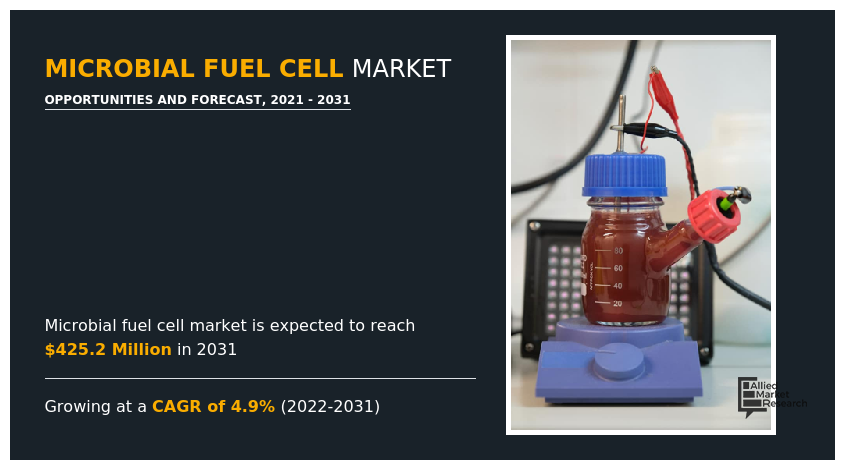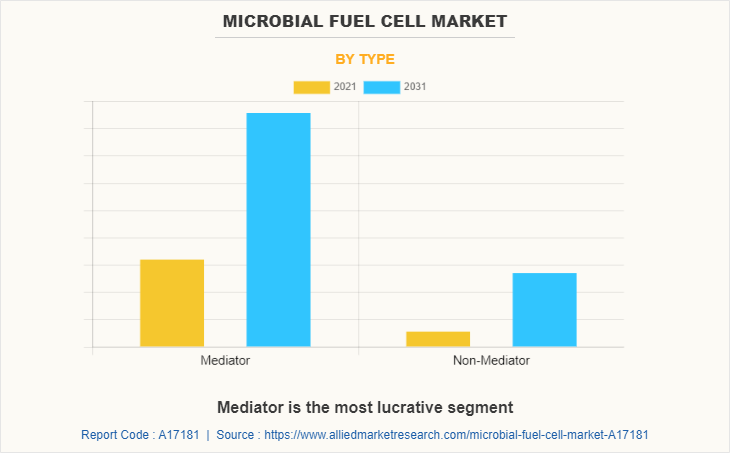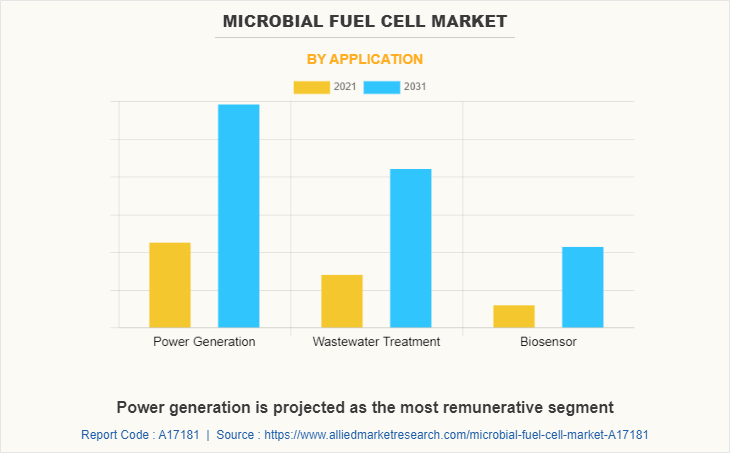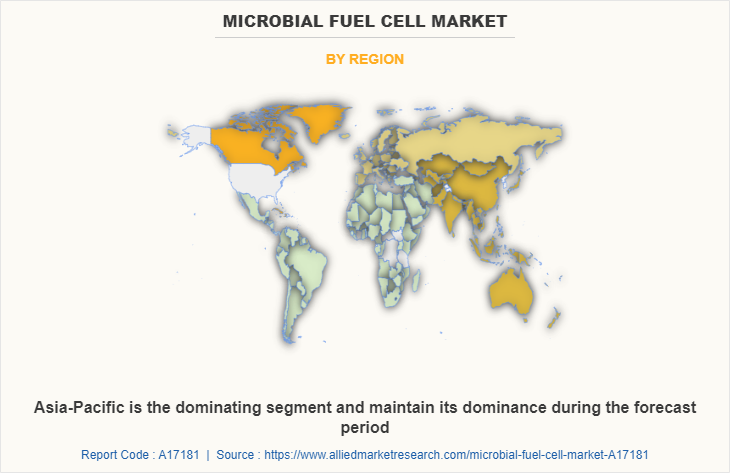Microbial Fuel Cell Market Research, 2031
The global microbial fuel cell market size was valued at $264.8 million in 2021, and is projected to reach $425.2 million by 2031, growing at a CAGR of 4.9% from 2022 to 2031.
Microbial fuel cells (MFC) are a new generation of fuel cell technology that employ the use of organisms and transform the released energy into electrical energy. Since they do not use fossil fuels to generate power, these cells are environmentally beneficial and run-on food waste, sewage, and wastewater. As long as there is a supply (food) to feed the bacteria present in the microbial fuel cell, they continue to produce power by reproducing.

The microbial fuel cell possesses various properties such as electrical conductivity, resistance to corrosion, high mechanical strength, developed surface area, biocompatibility, and environmentally friendly owing to these functionalities microbial fuel cell is used in power generation, biosensor, wastewater treatment, hydrogen production and desalination process. A crucial factor in the growth of the global microbial fuel cell market is rise in environmental consciousness and the demand for more energy. Further, rising in industrialization, urbanization, a rise in disposable income, and end user such as medical, agriculture, food and beverages industries. Despite the benefits of technology, there are still certain practical obstacles to take into account, such as the insufficient electricity output, unstable current, high internal resistance, and expensive materials employed, which hamper the growth of microbial fuel cell market. These factors are responsible for the decline of the microbial fuel cell market.
The microbial fuel cell is frequently utilized in the production of hydrogen as well as the supply of power to small devices, wastewater treatment facilities, and domestic energy consumption. These factors are anticipated to offer remunerative opportunities for the microbial fuel cell market during the forecast period.
The microbial fuel cell market forecast is segmented on the basis of type, application, and region. On the basis of type, the market is categorized into mediator and non-mediator. On the basis of application, it is divided into power generation, wastewater treatment, biosensor, and others. Region-wise, the market is studied across North America, Europe, Asia-Pacific, and LAMEA.
The global market microbial fuel cell analysis covers leading players that include AFC Energy PLC, AVL group Bloom Energy, Ballard Power Systems, Ceres, Doosan Corporation, Fuel Cell Energy, Inc., Horizon Fuel Cell Technologies, Integer Holdings Corporation, Nedstack Fuel Cell Technology, Plug Power, Inc, and SFC Energy AG. The global microbial fuel cell market report provides in-depth competitive analysis as well as profiles of these major players.

Based on type mediator is the largest segment during the forecast period. This is attributed to promising technology for producing renewable energy, MFCs are most likely to be used in the near future to produce electricity while simultaneously treating wastewater. Further usage, such as power sources for environmental sensors and environmental bioremediation are expected to drive the microbial fuel cell market during the forecast period.

Based on application power generation holds the highest market share during the forecast period. Owing to The rising emphasis on MFC is attributable to its capability to generate electricity from organic and inorganic compounds. As a result, there is expected to be an increase in demand for MFC in low- to medium-power applications.

Based on region asia-pacific is the fastest growing region during the forecast period. This is attributed to , the market for microbial fuel cells has seen strong demand because power consumption in the industry and residential sectors has increased. The recent surge in the sanitization, along with health consciousness among consumers is predicted to rise in wastewater treatment services market in Asia Pacific which is supposed to drive market for microbial fuel cell in the forecast period.
Impact of COVID-19 on the global microbial fuel cell market
The novel coronavirus is an incomparable global pandemic that has spread to over 180 countries and caused huge losses of lives and the economy around the globe. The microbial fuel cell market has negative impact due to the COVID-19 pandemic, owing to the disruptions in the supply chain for various industrial products. The outbreak of COVID-19 resulted in the shutdown of various manufacturing plants for a long period, especially in Europe, Asia-Pacific, and other regions due to which manufacturers have faced shortage in labor units, production losses, and the rising awareness regarding worker security, safety, and guidelines by government posed an additional challenge to resume their basic operations in manufacturing unit. In the first quarter of the pandemic, there is complete shutdown of food & beverage sector, manufacturing industry, and others due to the strict imposition of lockdown it has hindered the microbial fuel cell market growth.
Furthermore, disruption in the production unit, closure of manufacturing factories, and cutbacks in service sectors lead to disruption in global logistics and supply chain services. Moreover, the market for microbial fuel cells is primarily driven by increased energy demand in hospitals, residential and commercial sectors due to which the market is in a phase of development and growth and is expected to continue to see decent growth as a result of the widespread demand for renewable energy.
Key Benefits For Stakeholders
- This report provides a quantitative analysis of the market segments, current trends, estimations, and dynamics of the microbial fuel cell market analysis from 2021 to 2031 to identify the prevailing microbial fuel cell market opportunities.
- The market research is offered along with information related to key drivers, restraints, and opportunities.
- Porter's five forces analysis highlights the potency of buyers and suppliers to enable stakeholders make profit-oriented business decisions and strengthen their supplier-buyer network.
- In-depth analysis of the microbial fuel cell market segmentation assists to determine the prevailing market opportunities.
- Major countries in each region are mapped according to their revenue contribution to the global market.
- Market player positioning facilitates benchmarking and provides a clear understanding of the present position of the market players.
- The report includes the analysis of the regional as well as global microbial fuel cell market trends, key players, market segments, application areas, and market growth strategies.
Microbial Fuel Cell Market Report Highlights
| Aspects | Details |
| By Type |
|
| By Application |
|
| By Region |
|
| Key Market Players | Bloom Energy, Nedstack Fuel Cell Technology, AFC Energy PLC, SFC Energy AG, Integer Holdings Corporation, Doosan Corporation, Horizon Fuel Cell Technologies, Ceres, Fuel Cell Energy, Inc., Ballard Power Systems, Plug Power, Inc, AVL group |
Analyst Review
According to CXOs of leading companies, the global microbial fuel cell market is expected to exhibit high growth potential. Microbial fuel cell technology is a promising sustainable energy solution to deal with issues with non-renewable energy demand, climate change, and environmental degradation. Microbial fuel cells are used for removal of hazardous metal contaminants and organic dye pollution degradation in wastewater. Despite the advantages of this technology, there are still some huge obstacles to consider, such as the low electrical output, fluctuating current, high internal resistance, and high cost of raw materials.
In addition, rise in demand for mediator-free microbial fuel cell utilize electrochemically active bacteria that is expected to drive the growth in microbial fuel cells market during the forecast period. Moreover, the world desperately needs sustainable, efficient, and eco-friendly energy production. Furthermore, excellent mechanical integrity, low electronic conductivity, high ionic conductivity, and chemical stability over various circumstances drive the market for microbial fuel cell. Microbial fuel cells are employed as substitute over other fuel cell, owing to its corrosion resistance, electrical conductivity, and high mechanical strength properties that make customers more linear toward mediator-free microbial fuel cell.
The CXOs further added that sustained economic growth and the development of the power generation have surged the popularity of microbial fuel cell.
Panasonic, FedEx, Honda and Google are the potential customers of microbial fuel cell industry
Additional growth strategies, such as expansion of production capacities, acquisition, and partnership in the development of the innovative products from manufacturers have helped to attain key developments in the microbial fuel cell market trends.
A crucial factor in the growth of the global microbial fuel cell market is rise in environmental consciousness and the demand for more energy. Further, rising in industrialization, urbanization, a rise in disposable income, and end user such as medical, agriculture, food and beverages industries.
The global market microbial fuel cell profiles leading players that include AFC Energy PLC, AVL group Bloom Energy, Ballard Power Systems, Ceres, Doosan Corporation, Fuel Cell Energy, Inc., Horizon Fuel Cell Technologies, Integer Holdings Corporation, Nedstack Fuel Cell Technology, Plug Power, Inc, and SFC Energy AG.
By application, the power generation segment is anticipated to register the highest CAGR of 5.5% during the forecast period.
One of the areas for microbial fuel cells with the highest growth is the food and beverage sector. The food and beverage sector are a well-established industry in Europe and is regarded as one of the major economic drivers in the region.
Loading Table Of Content...



